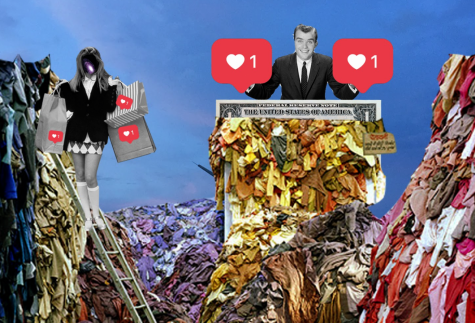Don’t Dig The Grave – Fast Fashion is Alive
If you want to buy new clothes, it’s as simple as going to the mall and grabbing something that might even be cheaper than your lunch. This fast process of buying clothes is called fast fashion. This $2.3 trillion industry focuses on producing garments in an accelerated way to meet the parallel consumer demand. A toxic business model that remains alive and thriving in a world seeking comfort, technology, and social media.
Today, fast fashion continues to prosper economically because of cheap production cycles and consumers who respond to them. The fashion industry produces about 150 billion garments a year. This production requires stores like Zara, H&M, and even luxury brands like Dior, to have factory sites in third world countries where they can create garments with underpaid workers. This practice allows prices to remain low and gives companies the privilege to ignore ethical concerns and contribute to environmental damage like wastewater and utilizing non-recyclable materials (polyester). Additionally, this industry can use its massive budget to continue production at any cost. Amancio Ortega, the owner of Inditex and fast-fashion brand Zara is currently the 13th richest person alive. Fast fashion has already secured investing in never-ending demands from consumers’ need for trends with these resources. On the other hand, it’s essential to recognize that supply chains have been affected by the pandemic, and businesses like Forever 21 are going bankrupt. Yet, this doesn’t mean there aren’t any more fast fashion giants with billions of dollars to fire low wage workers, hire new ones, survive a lawsuit (like UK’s Boohoo), and last another three pandemics. Profits are not a problem for fast fashion businesses, and the consumers are sure to provide that paycheck.

Technically, everyone is a consumer. Even if you claim you don’t like fashion, you dress every day in clothes, whether they’re a fast-fashion or not. Most consumers don’t know about fast fashion’s detrimental impact, allowing the industry to keep working. Sofia Arias, an expert on sustainable fashion and owner of a second-hand store, There’s No Labels, says that fast fashion is alive because “It’s something that brings us comfort. People tend to buy the first thing they see. People don’t think about what they’re buying; they buy as an impulse, they see something, they want it, they like it, and they get it.” Buying has never been as easy as it is now with technology, allowing consumers to buy impulsively and giving them access to misleading information that propels the fast fashion loop. Also, it’s been impossible to properly quantify and communicate the industry’s effects to the public because most companies fund foundations that report “minimum waste being generated.” Nonetheless, some consumers believe that fast fashion is ending because of information provided by brands like Zara that claim to “use sustainable, organic, or recycled material in all of its clothing by 2025,” or H&M has launched sustainable capsule collections. However, these are examples of a term called “greenwashing,” where misleading information is provided to consumers. Hence, they continue buying from brands, thinking that they’re changing to sustainable and ethical practices. In reality, these companies continue to produce large quantities, which requires a toxic and almost unstoppable manufacturing process that comes at a low price for consumers and a high one for the environment.
Moreover, the fast fashion industry continues being active and sees practically no competition or defeat from sustainable fashion businesses. Sustainable fashion businesses are mostly local brands that focus on providing an ethically made product and friendly to the environment. As mentioned by Amalia Abad, owner of sustainable brand Malai, “What we are trying at the moment is to sell less… We don’t want to sell and sell and get people addicted. We want to be selling because you need it.” Sustainable businesses hold a model different from fast fashion and can’t overcome it. Fast fashion is strong because it responds to consumers’ demands in response to monthly Instagram trends. In contrast, sustainable/slow fashion focuses on lasting clothes that entail a longer production process. Henceforth, profits are not as overbearing, and there’s not as enough budget to become as massive as the dominant fast fashion. Although second-hand stores like thredUP and Depop are gaining popularity from the young target generation, the “Gen Z” has popularized thrifting and environmentally friend-made clothes. The fast fashion industry continues to hold a significant grasp of the market today because of money and technology availability.
Fast fashion isn’t ready to die yet, and it can be frustrating to recognize that it persists, mostly due to a trillion-dollar industry that wants to keep going and fooling consumers. As put in the words of Sofia, “The future for fast fashion, in an idealistic world, is going to be one where people consume less of these brands. With this, I’m not saying that when you buy fast fashion, you’re committing a crime, but it’s about thinking twice before your decision and buying.”




